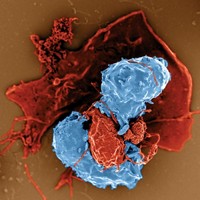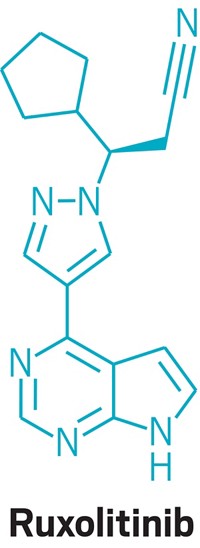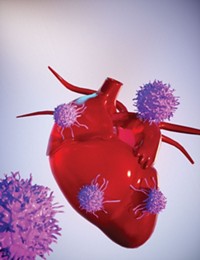Advertisement
Grab your lab coat. Let's get started
Welcome!
Welcome!
Create an account below to get 6 C&EN articles per month, receive newsletters and more - all free.
It seems this is your first time logging in online. Please enter the following information to continue.
As an ACS member you automatically get access to this site. All we need is few more details to create your reading experience.
Not you? Sign in with a different account.
Not you? Sign in with a different account.
ERROR 1
ERROR 1
ERROR 2
ERROR 2
ERROR 2
ERROR 2
ERROR 2
Password and Confirm password must match.
If you have an ACS member number, please enter it here so we can link this account to your membership. (optional)
ERROR 2
ACS values your privacy. By submitting your information, you are gaining access to C&EN and subscribing to our weekly newsletter. We use the information you provide to make your reading experience better, and we will never sell your data to third party members.
Cancer
Can immunotherapy tackle glioblastoma?
Researchers are developing new ways to get immune cells to brain tumors
by Megha Satyanarayana
October 28, 2018
| A version of this story appeared in
Volume 96, Issue 43
RETRACTION:
The paper describing how T cells might be engineered to fight glioblastoma in this article has since been retracted (Nature 2019, DOI: 10.1038/s41586-019-0967-z).

In 2016, after his seizures became more frequent and he started to lose motor function, Adam Hayden underwent surgery to remove a large brain tumor. Sitting in his neuro-oncologist’s office a few weeks later, he recalled the hesitation, the verbal gymnastics, of the oncologist trying to say that the 34-year-old father of three had an incurable cancer, glioblastoma.
“It is very unlikely that you will not have a reoccurrence,” Hayden recalls the doctor saying. This was a sobering revelation: After major surgery and a grueling protocol of chemotherapy and radiation, his cancer would be back. “That was a phrase that became a refrain in my mind. This cancer has my number.”
Glioblastoma is an aggressive cancer that strikes about six in every 100,000 people. It affects predominantly older white men and in recent years has claimed the lives of Sen. John McCain of Arizona; Beau Biden, son of former vice president Joe Biden; and Sen. Edward Kennedy of Massachusetts. Survival, even after standard treatment that includes surgery, chemotherapy, and radiation, is measured in months. With such grim prognoses, says Nabil Ahmed, an oncologist at Baylor College of Medicine in Houston, there is an urgency to find something, anything, that might turn the tide.
That thing may be immunotherapy, a field of research working to boost the immune system’s natural ability to kill cancer cells. In recent years, a group of immune-stimulating drugs called checkpoint inhibitors have had remarkable results in treating melanoma, earning two researchers the 2018 Nobel Prize in Physiology or Medicine. Cell-based therapies using engineered T cells have been successful in treating people with leukemia. And cancer vaccines are being studied as a way to prime the immune system to attack tumors by first feeding immune cells a sample of tumor antigens.
Ahmed and other oncologists who spoke with C&EN are hopeful that successes in immunotherapy with other cancers can be translated to glioblastoma. But the treatments can have catastrophic side effects, and when applied to the brain, other questions abound: How do you train the immune system to catch a cancer that grows blazingly fast? How do you slip immune cells through the blood-brain barrier to reach a tumor? And how do you apply immunotherapy to a cancer that successfully blocks the immune system time and time again?
“You need a marathon runner,” Ahmed says, referring to how he and others are trying to engineer immune cells to withstand the ways glioblastoma tries to wear them out.
But first, you have to get those engineered cells to the tumor. Then, you have to keep them alive long enough to kill the cancerous invaders.
It may be complex, dangerous, and in early stages of testing, but Ahmed says that the arsenal for glioblastoma needs help.
“Everything we have in our pockets does not work,” he says, stressing the urgency to get what’s in testing to people as quickly as possible. “We are doing things at a small scale when there are literally hundreds of patients waiting for it.”
Glioblastoma knows how to survive
Glioblastoma tumors are made up mostly of aberrant astrocytes, cells in the brain that maintain the nervous system. Tumors grow rapidly. They are adept at building their own blood supply. They are protected by a blood-brain barrier. They are genetically different from cell to cell, Brigham & Women’s Hospital Chairman of Neurosurgery E. Antonio Chiocca says, and this makes early detection hard.
Surgery leaves cancerous cells behind because glioblastoma likes to grow, tentacle-like, and extend into critical brain structures. And after chemotherapy and radiation, any cells left are hardy and sometimes resistant. So glioblastoma comes back, and when it does, treatment options become more limited.
Tailored therapies aren’t enough, Chiocca says. Doctors might kill those aberrant cells, but now their lingering neighbors have less competition to regrow the tumor.
With wiggle room for glioblastoma to regrow under current treatments—surgery, chemotherapy, radiation, blood-vessel-blocking drugs, and even electrical stimulation—immunotherapy has become a popular avenue of study because of its potential to reach the cancer cells that established treatment misses.
But first, there has been a reckoning about the role of immune cells in keeping the brain healthy.
For decades, researchers thought the brain was less immunologically active than the rest of the body. Michael Lim, a Johns Hopkins Medicine neurosurgeon, says that’s not the case but that tumors like glioblastoma are “cold”—the immune cells around them are suppressed or show markers of fatigue.
“It happens at multiple levels,” Lim says. “T cells are being actively deleted and inactivated” in glioblastoma tumors.
This matters because T cells are one type of immune cell that attacks a tumor and are the subject of much engineering effort to boost that tumor-fighting potential. Lim says that if you look at the environment around glioblastoma, you’ll find other immune cells like macrophages and microglia. Something they are doing, maybe under the command of the tumor itself, is keeping those T cells at bay.
Getting T cells to the tumor and keeping them alive and active is where Baylor College of Medicine’s Ahmed and a researcher named Heba Samaha of Children’s Cancer Hospital Egypt think their work can make a difference. And they are looking to another brain disease for clues.
Getting T cells to slow their roll

Researchers in Houston and Egypt are engineering T cells to better find their way across the blood-brain barrier. A: T cells that have copies of the CD6 binding domain on their surface bind to ALCAM, a cell adhesion molecule found on blood vessel cells feeding glioblastoma, a cancer of astrocytes. B: This binding helps slow the flowing T cells down, allowing them to tether to the blood vessel wall. C: With the right signals, the T cell changes shape and squeezes through and around blood vessel cells to reach its destination.
To get to their destination in the brain, T cells coursing through blood vessels respond to “flags” on the blood vessel cells themselves. They grab on to these flags to slow their movement, eventually tethering tightly enough to squeeze through the spaces between the cells and into the brain.
The flags are part of a family of proteins called cell adhesion molecules. In the brain disease multiple sclerosis (MS), something about this tethering system goes awry, and the T cells that get through the blood-brain barrier are ones that lead to autoimmune destruction of the nervous system.
Samaha and Ahmed saw in this a possibility: Some part of the mechanism that allows T cells to get through the blood-brain barrier in MS might be a good way to get T cells through the blood-brain barrier in glioblastoma. Samaha engineered T cells to carry a repeating segment of a natural ligand that binds to one of these cell adhesion molecules, called activated leukocyte cell adhesion molecule (ALCAM). The researchers saw that the interaction between the repeating segment and ALCAM slowed T cells down as they tumbled through the bloodstream, allowing them to attach and squeeze through the blood-brain barrier in higher numbers. Coupled with a molecular system that targets glioblastoma, the engineered T cells were able to kill off glioblastoma cells in mice (Nature 2018, DOI: 10.1038/s41586-018-0499-y).
Ahmed is impatient to move the project into clinical trials to augment other immunotherapy systems that he says work but could work better.
“This makes it more effective,” he says of the homing system’s impact on immunotherapy. “The next step is to give it more stamina, to make it more resistant to the other mechanisms whereby the tumor cells try to disassemble the immune system.”
One way the tumor goes after the immune system itself, Lim says, is through a class of enzymes that glioblastoma makes called indoleamine 2,3-deoxygenases. The enzymes catalyze the rate-limiting step in the formation of kynurenines from tryptophan. These catabolites seem to force T cells into arrest and maybe even cell death (Cell. Mol. Immunol. 2018, DOI: 10.1038/cmi.2017.143).
Combine that tumor-led immune suppression with suppression triggered by radiation therapy and low white blood cell counts caused by chemotherapy, and it might seem counterintuitive to try to program a more-or-less nonexistent immune system to kill glioblastoma.
“Clinically, we are trying to redefine this,” Lim says of treatment, with researchers exploring adding drugs such as Genentech’s bevacizumab (Avastin), which blocks the tumor’s blood supply.
As for Samaha and Ahmed’s homing system, Lim says it’s a good first step, but if you don’t tamp down the macrophages and microglia that hold T cells at bay, you’ll be right back where you started: an immunologically cold tumor that may not respond well to treatment.
“Just bringing a bunch of soldiers to the battlefield that haven’t been trained is not going to get you the win,” he says.
Immunotherapy might be a compassionate-use issue

But that win is critical, says David Arons, the CEO of the National Brain Tumor Society. Like the scientists who study immunotherapy for glioblastoma, he is hopeful that something will come out of clinical trials soon. He says he hears from patients with glioblastoma who are trying checkpoint inhibitors, drugs like Merck & Co.’s Keytruda and Bristol-Myers Squibb’s Opdivo that take the brakes off immune cells, either off label or as part of a clinical trial.
But checkpoint inhibitors are different from the T-cell engineering Ahmed is working on, and along with him, Arons wonders if glioblastoma and immunotherapy may be the nexus of so-called compassionate-use requests, in which people with life-threatening diseases can access treatments still being tested for safety and efficacy.
“You’ve got to be all in. It’s a big deal,” Arons says of immunotherapy. “Many are willing to do this level of exploration,” but they’re willing only up to a certain point. If patients are really running out of energy, Arons says, they might not be up to the challenge of trying immunotherapy, which can involve removing a person’s T cells, taking time to engineer and grow them, and returning them to the right portion of the brain.
Younger patients will likely do better with T-cell engineering protocols, Chiocca says. And this piques the interest of Hayden, as he enters his second year of stable scans since his first round of treatment. He’s a long-term survivor, but he also knows his time is limited.
Advertisement
Immunotherapy wasn’t an option for him the first time around, he says, because the treatments are generally used only when cancer recurs. So he’s curious, hopeful he’ll qualify when the time comes, knowing he might need to educate his doctor about this rapidly moving field but also doing his best not to spend his days thinking about what’s coming down the pike. Many clinical trials are unsuccessful.
“It’s a strange way of viewing the world, but until recurrence, I’m just hanging out,” he says.





Join the conversation
Contact the reporter
Submit a Letter to the Editor for publication
Engage with us on Twitter